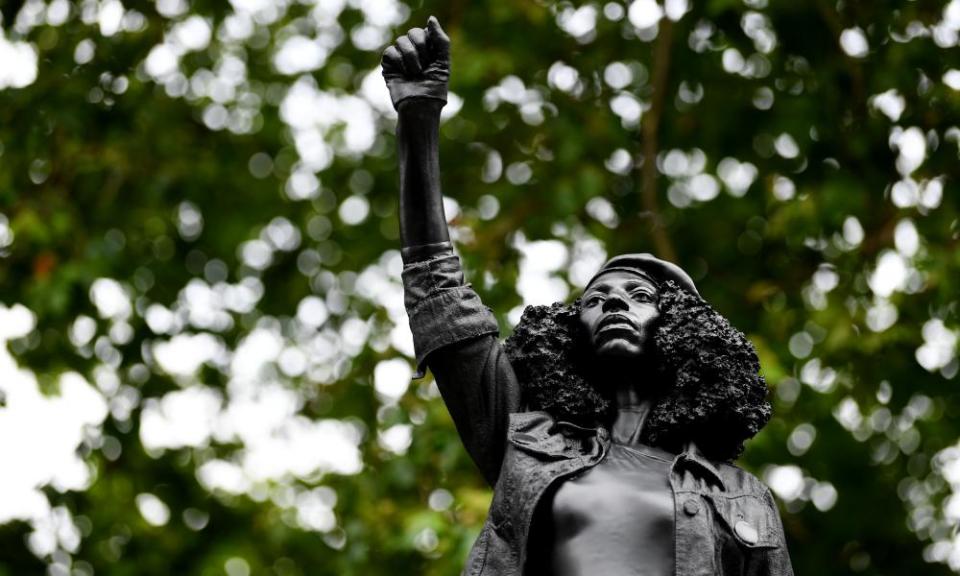Sculptor unveils ‘black everywoman’ as UK row over statues and race grows

What kind of statue can represent black British women today? It is a question the sculptor Thomas J Price believes he has answered.
After the controversial appearance of the statue of a Black Lives Matter protester on the plinth formerly occupied by an effigy of Edward Colston in Bristol last Wednesday, Price has unveiled a new work destined for east London.
Reaching Out shows a woman looking down at her mobile phone and is intended as a black “everywoman”, shown in a relaxed, modern pose.
“It was important to me not to have to fulfil a certain expectation, like the idea you would have to be a top athlete, or a Black Panther or a politician to be up there,” Price told the Observer. “It is a fictional character based on various references. I did have someone model for part of it but she remains anonymous.
“All the characters in my work are anonymous. I want to show something about their inner world, rather than their public roles. I want to show people at a natural moment. That can look vulnerable, but it is strong really, because there is no facade.”
Price, who has recently been commissioned to make a statue to commemorate the Windrush generation for Hackney town hall, was angered by artist Marc Quinn’s overnight intervention last week in Bristol.

“Quinn effectively colonised that space in Bristol again in a way that sabotaged the process that was going on in the city,” said Price. “I don’t regret what I have said because I feel it was a strategy designed to increase his own profile, despite what he says about wanting to show allegiance. And it was a strategy that he had the money to go in and do without asking.”
Price, 39, believes his bronze statue can bear the weight of expectation in a context that has become heavily politicised. The statue of slave trader and philanthropist Colston was torn down and thrown into Bristol harbour last month. Then Quinn, an artist best known for a bust he made in frozen blood, replaced it overnight with a statue he had made from a 3D scan ofJen Reid re-creating the moment she stood on the empty plinth giving the black power salute.
Quinn’s statue was taken down and the artist has since been asked to pay the city council’s costs. Marvin Rees, the mayor of Bristol, ordered its removal, saying the people of Bristol should choose what stood there.
Price regards Quinn’s overnight “guerrilla” action as seriously misjudged. “It was a clear case of opportunism. It was a great image, I agree, but the idea that it was intended just to start a debate I don’t believe. Quinn could have done it anonymously, but he put himself right at the centre of it,” he said.
“I understand why Jen Reid would have felt it was a good idea. It is appealing, but I suspect it was a stunt. For a start it was made in resin, not in the bronze of power. People have said to me I should keep quiet and not rock the boat, but I am disappointed in them for not speaking out.”
Price’s latest statue will be one of very few in Britain of black female subjects. Those in London already include a prominent one of Crimean war nurse Mary Seacole outside St Thomas’s hospital and one of a woman and child in Stockwell Gardens, south London.
It had taken two years to raise the funds to make Reaching Out, Price said, and the statue was now being cast at full size in a foundry in Farnham, Surrey.
Once erected on 5 August on Three Mills Green in Stratford, the 9ft statue will take its place as part of the acclaimed public art walk called The Line.
Price, who studied at Chelsea College of Art and the Royal College of Art, and who has had major shows at the National Portrait Gallery and the Yorkshire Sculpture Park, says the title of the work has a double meaning. The figure is using her phone, but she is also allowing the artist to reach out. “Is she calling someone or being called? There is a bit of push and pull, a feedback loop there,” he said.
“In the past I have concentrated on the male black form, but after talking with lots of black women, I found a way of showing what representation can look like.”
The Line follows the Greenwich meridian on a route passing through the London boroughs of Newham, Tower Hamlets and Greenwich. Price’s work joins Antony Gormley’s Quantum Cloud and Gary Hume’s Liberty Grip.

 Yahoo News
Yahoo News 
